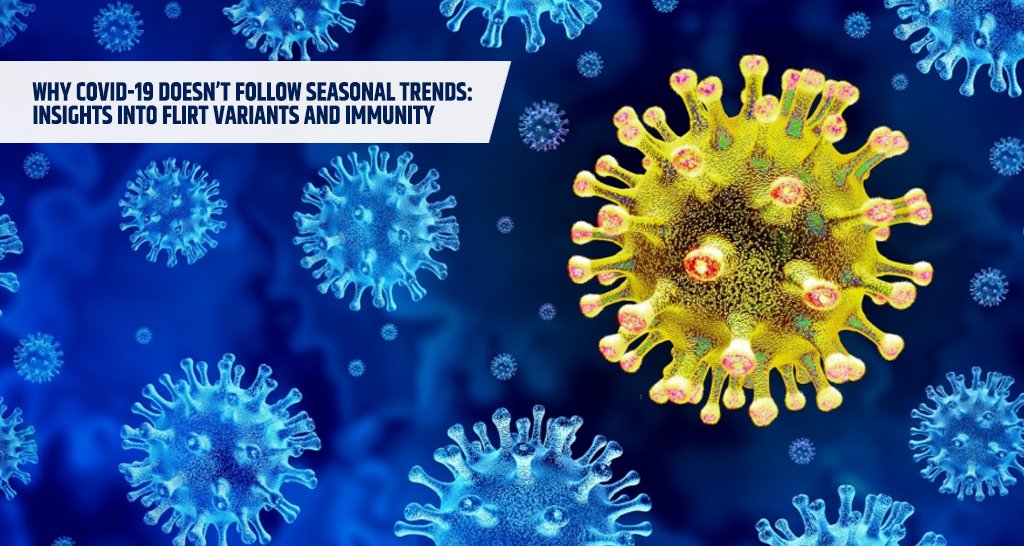Every summer since 2020, the United States has seen a surprising increase in Covid-19 cases and hospitalizations, called the “summertime surge.” This year, states like Arizona, California, Hawaii, and Nevada have had particularly high rates of positive tests, with numbers reaching 15.6% in early July. The UK is experiencing a similar situation, with positive tests rising from 4% at the end of March to 14% by the end of June. It’s important to understand why Covid-19 doesn’t follow the seasonal patterns of other respiratory viruses to develop better public health strategies.
The Role of FLiRT Sub-Variants
The recent increase in Covid-19 cases is mainly due to new versions of the Omicron strain called FLiRT sub-variants, which appeared at the end of 2021. These new versions have changed in a way that helps them avoid the immune system while still being able to attach to human cells. Shan-Lu Liu leads the Viruses and Emerging Pathogens Program at The Ohio State University. He explains that these sub-variants have found a way to avoid the immune system and bind to cells. This ability is causing more new infections.
Vulnerable Populations
The elderly and people with weak immune systems are especially at risk because their bodies don’t respond as well to vaccines or infections. Experts suggest getting booster shots, such as the XBB.1.5 monovalent vaccine designed to fight the Omicron XBB 1.5 subvariant. These vaccines are developed by studying the latest changes in the virus, and this information helps US regulators and the World Health Organization make their recommendations.
Covid-19 and Seasonality
Most respiratory viruses, like the influenza and Respiratory Syncytial Virus (RSV), have seasonal patterns and peak in the autumn and winter months. However, Covid-19 does not follow this cycle yet. This unpredictability makes it hard to know when new strains will appear and when there will be surges in cases.
Several things affect the seasonal patterns of infectious diseases, including the virus itself, how easily people can get infected, and the environmental conditions. For the flu, lower immunity and higher transmission rates are influenced by environmental and behavioral factors. However, influenza never fully disappears, and the same complexities apply to Covid-19.
Behavioral and Environmental Factors
A professor at Yale University explains that summer COVID-19 waves tend to worsen due to factors such as festivals, concerts, and air conditioning, which dries the air and facilitates the spread of the virus. In the UK, the Euro 2024 football tournament likely contributed to an increase in COVID-19 cases as people gathered in pub gardens and bars.
Population Immunity
One reason Covid-19 does not follow a clear seasonal pattern is lower population immunity compared to other seasonal viruses. Influenza, rhinovirus, and RSV have been around for a long time, so many people have already built up some immunity to them. Covid-19, being relatively new, so not many people have immunity to it yet. The problem is made worse because not enough people are getting vaccinated. As of early July, only 22.7% of adults in the US have had their latest Covid-19 vaccines, while 48.2% are up-to-date with their flu shots.
Experts from The City University of New York explain that changes in immune responses have influenced the frequency and intensity of COVID-19 waves. The new FLiRT variants, which share similar mutations with those responsible for the significant COVID-19 wave in winter 2023, exploit the decline in immunity.
Future Predictions
It is still unclear if Covid-19 will become seasonal like the flu. Some experts think Covid-19 might become seasonal because the recent summer surge is not as severe as the winter peaks. In June, the US recorded 327 Covid-19 deaths, compared to 2,578 in January.
Some experts think it might take another year or two for Covid-19 to become seasonal, while others believe it could take decades. This is because human exposure to viruses like influenza has been happening for centuries, setting a high bar for Covid-19.
Virus Interference and Public Health Messaging
The idea of “virus interference” suggests that when one virus infects someone, it can offer some temporary protection against other viruses. This might explain why different viruses do not peak at the same time. If COVID-19 settles into a seasonal pattern, it will need to share time with peaks of RSV and influenza.
Another expert notes that human coronaviruses did not follow strong seasonal patterns before 2020 and often caused “summer colds.” This natural behavior of coronaviruses might mean that COVID-19 will not strictly follow seasonal trends.
Ongoing Public Health Challenges
Because COVID-19 affects people all year round, it is important to keep up public health efforts to make sure vulnerable groups stay vaccinated and have access to antiviral treatments. Experts stress that people should stay updated on vaccines throughout the year, not just in the fall and winter.
In conclusion, the regular summer increases in COVID-19 show that this virus behaves differently from other respiratory infections. As the world continues to deal with this evolving threat, it is important to understand how viral changes, immunity levels, and environmental factors interact to create effective strategies for managing COVID-19. For now, staying alert and keeping public health measures up-to-date is crucial for protecting vulnerable people and reducing the impact of future outbreaks.












